Content
Feeding dry cows is an important step in preparing the uterus for calving. It is necessary not only to meet the launch dates, but also to provide the animal with all the necessary nutrients. At the same time, the needs of the cow during the dry period change very quickly. And for each stage, the diet must be calculated separately.
What is this term "dry cow"
A common abbreviation for the phrase "pregnant dry cow". The optimal duration of the dry period is 2 months. It cannot be reduced, as otherwise the calf will be born with congenital diseases. The queens are not milked at all at this time. Up to the point that cows' milk burns out. Therefore, they are called dry: it is impossible to get products from an animal at this time.
The dry period is preceded by a "launch". Low-yielding cattle have a short lactation period, and they are able to leave on their own during the "launch". Worse with high-yielding individuals. You need to be able to run the cow so that she does not get mastitis.
But the way is pretty simple. "Start-up" begins about a month earlier than the beginning of the dry period. The cow's diet is cut by 70-80%. It is completely removed from juicy feed and concentrates, leaving only hay. It is better to provide free access to water so as not to cause dehydration. Milk continues to be milked, but they no longer try to milk every last drop.
The frequency of milking is also gradually reduced. With a “dry” diet cut back, milk will start to disappear rather quickly. After the milk yield has decreased by ¾, milking can be stopped altogether.
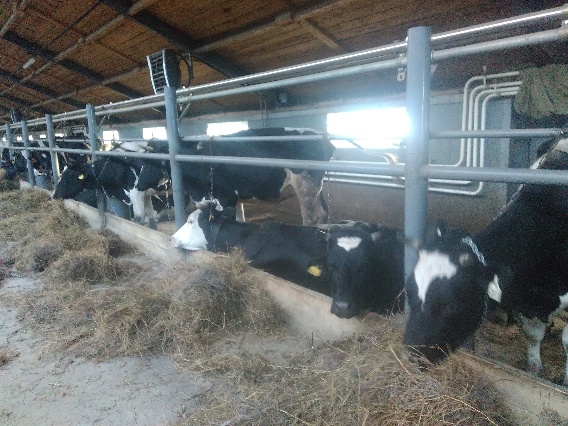
The dry period usually occurs in winter.
Features of keeping dry cows
The technology of keeping and feeding dry cows includes not only the calculation of the ration. Since these are pregnant animals, the conditions of their keeping must also be taken into account.
Methods:
- tethered;
- loose with deep bedding;
- loose-boxed.
Each method assumes a certain sanitary area for one cow. Since the dry period presupposes a deep pregnancy, dry queens and heifers should have at least 4 m² if livestock are kept loose on deep litter. Boxing size: 1.9x2 m.With the tethered method, stalls are used, the size of which is 1.2x1.7 m.
The containment system can be:
- stall-pasture: use of pasture and farm buildings;
- stall-walking: pens for walking are adjacent to the farm, they are used in the absence of pastures, cows are kept in pens even in summer, providing them with freshly cut grass;
- camp-pasture: livestock for the summer are transferred to camps on pastures, the main premises at this time are sanitized and repaired;
- camp-stall: in the absence of grazing, cows are kept in corrals around the clock, green fodder is brought up daily.
Large farms use a line-shop milk production system. With this method, the cows calve all year round so that the conveyor is not interrupted. It is very important for continuous production that even in summer there are dry cows on the pasture, which will calve after 2-3 months. Such an alignment is unprofitable for a private owner with one animal. He'd rather raise a calf on free grass than feed him expensive concentrates and hay in winter.
The line technology of keeping dry, pregnant and lactating cows provides for the division of animals into groups depending on their physiological state. These groups are formed by workshops:
- milk production;
- milk and insemination;
- calving;
- dry cows.
The first workshop is the largest in terms of the number of livestock and the duration of keeping animals in it. He is allocated 50% of the total livestock and 200 days to stay in this department. Accordingly, for the calving workshop - 11% and 25 days; for milking and insemination - 25% and 100 days; for dry cows - 14% and 50 days.
But if the types of maintenance for a private owner are not of particular importance, then the system of rationed feeding of dry, pregnant cows and heifers may well be applied on a personal backyard.
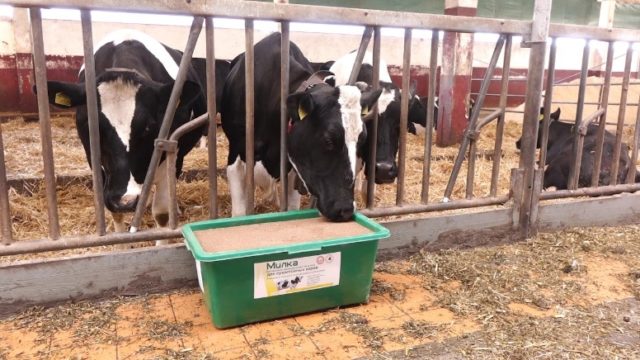
Lick salt with appropriate additives is used to meet the mineral requirements of dry cows.
The Importance of Formulating the Right Diet
Inadequate feeding often causes complications during and after calving, weak calves, poor offspring development and low milk yield in the subsequent period. Due to the fact that the main problems with calves are "laid" in the last two months, special attention is paid to feeding cows during the dry period. At this time, the calf grows very intensively, and the weight of the uterus of average fatness during the dry period increases by 10-15%. If the body condition of the cow is below average, then the gain is even greater.
Feeding rules for dry cows and heifers
The requirement for nutrients in adult dry cows is 1.5-2 feed. units per 100 kg of live weight. Calculate the norm based on the average body condition. If the uterus is underweight, the rate is increased.
Exceeding the feeding norms leads to obesity of the animal, which is the main cause of heavy calving and postpartum complications. Diets for heifers and dry cows do not differ in structure, that is, animals receive the same feed. But there are serious differences in the rationing and percentage of feed.
Feeding rates for heifers
A cow grows up to 5 years old, and it is covered in a year or two. Accordingly, the heifer brings the first calf, being no more than 3 years old. At this time, nutrients for growth are needed not only by her offspring, but also by the heifer herself. Because of this, the diets of heifers and dry cows differ from each other: per 100 kg of live weight, the first one requires more feed units. Moreover, the diet is calculated based on the level of expected productivity and gestational age.
In total, young cows have 5 periods of pregnancy, which take into account not only the stage of development of the embryo, but also the weight gain of the animal itself. The average daily weight gain for heifers should be at least 0.5 kg.

During the first pregnancy, the heifer size is only 70% of the adult cow.
In the first period
The initial stage of pregnancy is 1-3 months. At this time, the weight of the heifer is 350-380 kg. At the first stage, the diet of heifers is the same as that of young gobies or barn animals. At the first stage of pregnancy, animals do not yet need specific feeding.In total, the heifer should receive 6-6.2 feeds. units per day. The preferred feed is hay + roots or grass.
In the second period
The second stage starts from the 4th month and ends on the 6th. By the beginning of the second trimester, the heifer should weigh 395-425 kg. But feeding rates are increasing slowly. At this stage, the young animal receives 6.3-6.5 food. units per day.
The last trimester of pregnancy in a heifer
For the last 3 months, the heifer begins to gain weight rapidly: 440-455-470 kg. She needs more feed. Monthly she is added 0.5 feed to her. units: 7.0-7.5-8.0.
During the entire period of pregnancy, in addition to the nutritional value of feed, other elements, respectively, increase:
- phosphorus;
- calcium;
- magnesium;
- iron;
- sulfur;
- potassium;
- copper;
- other essential micro and macro elements.
The need for vitamins D and E is also increasing. More detailed data on the needs of heifers during pregnancy can be found in the table:
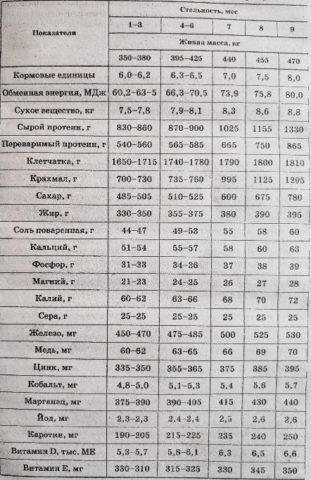
Nutrient rates for heifers per heifer per day
There is no need to cut their diet in the first decade of the eighth month of pregnancy.
Feeding rates for pregnant dry cows
Dead wood takes only 2 months, but the calculation of the diet is rather complicated, since it is produced every ten days:
- I - the total level of feeding is 80% of the required, this is the "start" time;
- II - feeding rates are raised to 100%;
- III-IV - the norm is 120% of the usual diet;
- V - again lower the rate to 80%;
- VI - give 60-70% of the norm.
Feeding rates are calculated in feed units. But this is not the only thing that matters. It is necessary for the uterus to receive the required amount of protein. It is not enough just to calculate how much crude protein the animal will receive. You also need to understand how much protein will be absorbed by the cow's body. A lack of protein leads to dystrophy in the newborn calf.
Disruption of the sugar protein balance causes physiological immaturity and dyspepsia in calves. Normally, sugar should be related to protein as 0.8: 1.0. Lack of carotene causes a decrease in the quality of colostrum, miscarriages and the birth of weak calves. With a lack of minerals and vitamin D, the appearance of osteodystrophic diseases in calves is possible.
The nutritional requirements for feeding dry cows are shown in the table below. Calculation for 1 head per day.
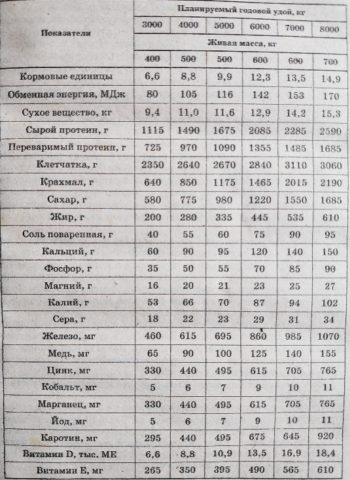
All norms are calculated for full-aged cows of average body condition.
Young queens under the age of 5 years are added 5 feed each. units and 0.5 kg of digestible protein for every kilogram of live weight gain.
Features of feeding dry cows at different periods
Since, due to the flow of milk production, dry queens are found on large farms even in summer, rations for them are developed depending on the season. The only general rule of thumb for dry cattle and heifers is to feed 2-3 times a day. But we are not talking about free pasture grazing, but about the rationing of feed. The amount of concentrates is especially strictly monitored, since it is they that can lead to obesity.
Feeding dry cows in winter
The diet of cattle in winter consists of three parts: roughage, root-tuber fruits, concentrates. The quantity is calculated not by weight, but based on feed units:
- hay / straw - 50%;
- juicy feed - 25%;
- concentrates - 25%.
The volume of concentrates will be the least. On average, their share by weight is only 1.5-2.0 kg.
Feeding dry cows during the stall period
Stable and winter periods are usually equivalent concepts. In the summertime, they try to keep livestock on free grazing. Animals are placed in the premises only after the grass has completely disappeared on the pastures. But there are situations when the farmer does not have extra land. In this case, the stall period continues throughout the year.
The difference is that in winter only hay is given to livestock, and in summer a significant part of dry roughage is replaced with fresh grass.In summer feeding with stall keeping cows are given:
- hay - 2-3 kg;
- silo - 2-2.5 kg;
- haylage -1-1.5 kg;
- root vegetables - 1 kg;
- grass - 8-10 kg.
All data are based on 100 kg of weight. That is, before calculating the diet and feeding rates, you need to find out the weight of a dry uterus or heifer. The amount of concentrates is calculated not per live weight, but per head: 1.5-2 kg per day. The frequency of feeding is the same as in winter: three times a day.
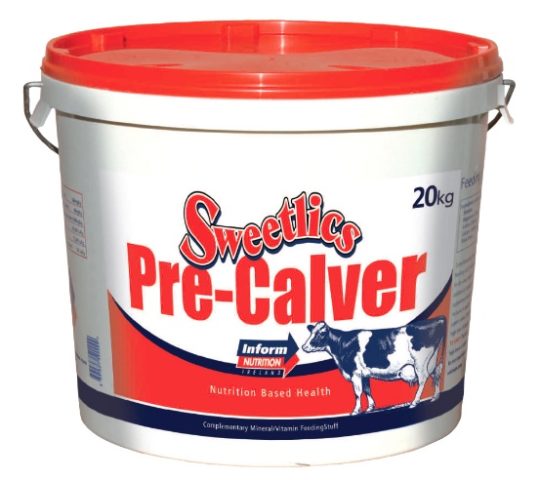
In the absence of a special salt lick, the premixes are added to the feed mixture before distribution.
Feeding dry cows in the grazing period
The transition from winter stables to summer grazing is carried out gradually. An abrupt change from dry, but fiber-rich hay to young succulent grass causes intestinal upset. The microflora does not have time to rebuild. Diseases of the gastrointestinal tract lead to disruption of the normal course of pregnancy.
At first, heifers and dead queens are fed with hay, but not with concentrates, before pasture for grazing. Well-fed cows are not so eagerly grabbing young, fiber-poor grass. Cereals before pasture are contraindicated, since in combination with plant sap they can cause fermentation in the rumen. The duration of grazing is also increased gradually.
When grazing on pasture, it is impossible to accurately control the amount of grass eaten by livestock. A cow can eat up to 100 kg of plants per day. Feeding for pasture grazing is carried out only when placing livestock overnight on the farm. At this time, hay and concentrates are given.
On the pasture, the chemical composition of the soil is monitored, since the plants have nowhere to take various elements, except from the ground. Control is necessary in order to know what kind of bait is important for pregnant animals.
Grazing on natural and planted pastures has its pros and cons. The species composition of plants is naturally richer. This allows the cow to choose what she wants. On the seedbed, it is easier for the owner to control the nutritional value and chemical composition of the grass.
The table lists the most common forage grasses and their main chemical composition.
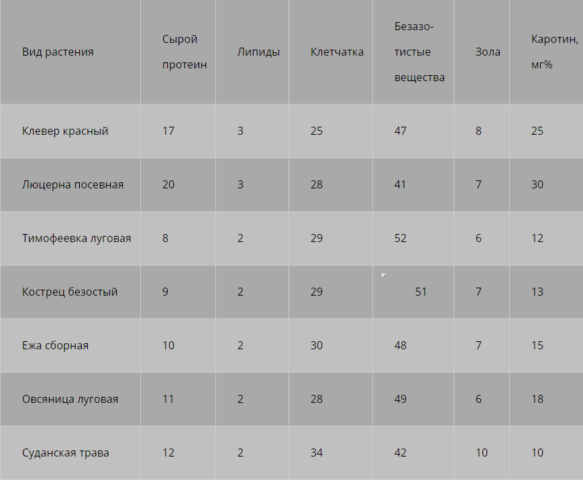
The balance of cow nutrition is an important element of the harmonious course of all periods of pregnancy.
Rates and rations for feeding dry cows
The ration rates are calculated individually for each region, since the nutritional value and chemical composition of herbs directly depends on the soil. In one region, it is imperative to add iodine to cattle feed, in another it will cause diseases due to an overabundance of the element. There are areas poor in sulfur or zinc. Therefore, when compiling a diet, it is imperative that feed samples are sent for chemical analysis.
The nutritional value of hay also depends on the type of grass and the mowing time. Too sooner or later mown hay has a lower nutritional value than with timely harvesting. Hay caught in rain means minus 50% of the predicted nutritional value and vitamin content.

"Hospital-average" nutritional value of the main feed used in animal husbandry
Can be taken as a starting point, but should not be taken as an axiom.
Feed requirements
Feeds for dry, pregnant cows and heifers, first of all, should not cause problems with the gastrointestinal tract. This means high quality requirements. Hay that has been in the rain is given very carefully. It can be moldy.
Silage intended for pregnant livestock should have a pleasant sauerkraut smell. It is also better not to feed the rest of the sour cattle, of course. Concentrates should be free of musty or mushroom odor. Frozen juicy food is not fed either.
When calculating feed units, they are especially careful with grain concentrates. For 1 feed. units accepted 1 kg of oats. However, most grains and legumes for livestock have a higher nutritional value:
- wheat - 1.06;
- barley - 1.13;
- peas - 1.14;
- soybeans and corn - 1.34.
The same applies to additives such as oilcake and meal.
In succulent feed, due to the large amount of water, the nutritional value usually does not reach even 0.5 feed. units The nutritional value of hay and straw depends on the type of cuttings, drying conditions and harvesting time.
Feeding pregnant dry cows and heifers before calving
Immediately before calving, in the last decade of pregnancy, feeding rates are cut by 30-40% to avoid mastitis. Just at this time, the udder begins to swell in the queens and colostrum is produced. Cows are transferred to feeding only with hay, completely excluding concentrates and juicy feed.
What not to feed dry cows and heifers
Probably easier to say than it can be: good quality feed. Everyone else is not allowed. Do not feed dry pregnant cows and heifers:
- frozen roots and tubers;
- frozen silage;
- rotten and moldy feed.
It is not just impossible, but forbidden to feed heifers and dry cows with carbamide (urea) and other supplements of non-protein origin, containing nitrogen.
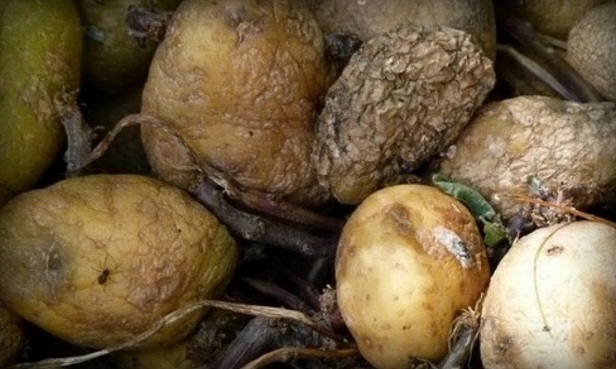
Never give spoiled potatoes to livestock.
Conclusion
Proper feeding of dry cows lays the foundation for the future productivity of the uterus and allows you to get a quality calf. Attempts to save on feed or milk the cow for longer than possible lead to serious postpartum complications in both the uterus and her offspring.








